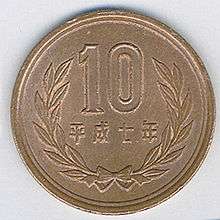Date and time notation in Japan
Date and time notation in Japan has historically followed the Japanese calendar and the nengō system of counting years. At the beginning of the Meiji period, Japan switched to the Gregorian calendar, but for many domestic and regional government paperwork, the Japanese year is retained. Japanese business and the people have also adopted various conventions in accordance with their use of kanji, the widespread use of passenger trains, and other aspects of daily life.
Date

The most commonly used date format in Japan is "year month day (weekday)", with the Japanese characters meaning "year", "month" and "day" inserted after the numerals. Example: 2008年12月31日 (水) for "Wednesday, December 31, 2008". The weekday is usually abbreviated to a single character, e.g. 水 for 水曜日 ("Wednesday"), but may also be written in full, then usually without surrounding parentheses. Apart from the Gregorian calendar, the Japanese Imperial calendar is also used, which bases the year on the current era, which in turn is based on the current emperor. The current era is 平成 Heisei and began in 1989. When using the Imperial calendar, the year is prefixed with the era. For example, the above date using the Imperial calendar is written as: 平成20年12月31日 (水); a more direct translation might be: Heisei year 20, Dec 31 (Wed).
Either form may be abbreviated as yy/mm/dd; periods as separators are not uncommon either. Examples: 20/12/31, 08.12.31. Ambiguities as to which calendar is used for the year are usually only resolved by the context in which the date appears, but Imperial calendar dates may be prefixed with a single character or letter denoting the era, e.g. 平20/12/31 or H20/12/31. This is a shorthand notation and full dates are often the preferred way of resolving such ambiguities.
Time
Using the Japanese notation, times are written as "8時42分", with the characters for "hour" and "minute" (optionally also 秒 for "seconds") added after the numerals. It is also common to simply write 8:42 though.
The 24-hour notation is commonly used in Japan, especially in connection with train schedules; nevertheless 12-hour notation is also routinely used, by adding the markers 午前 ("before noon") and 午後 ("after noon") in front of the time, so Japanese people are usually comfortable with either method of telling time. Some businesses write "AM/PM" before the time as in AM12:00 or PM12:00, which is in line with the Japanese word order of telling time, but is opposite to the convention in other English speaking countries. When using 12-hour notation, midnight is often still written as 0, e.g. 午前0時15分 or 0:15 for "quarter past midnight".
Times past midnight can also be counted past the 24 hour mark, usually when the associated activity spans across midnight. For example, bars or clubs may advertise as being open until "26時" (i.e. 2 am). This is partly to avoid any ambiguity (2 am versus 2 pm), partly because the closing time is considered part of the previous business day, and perhaps also due to cultural perceptions that the hours of darkness are counted as part of the previous day, rather than dividing the night between one day and the next. Television stations will also frequently use this notation in their late-night scheduling. This form is rarely used in conversation.